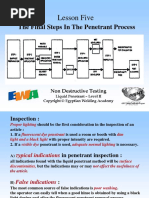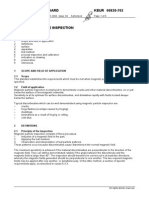Crack Detection Methods
Uploaded by
ankurCrack Detection Methods
Uploaded by
ankurCrack Detection Methods
Introduction:
When a load is applied to a specimen treated with brittle coating, cracks form in the
coating. If the coating has cured with a residual tensile stress, these cracks remain wide
open after the load is removed. For the accurate use of the coatings for either directional
information or stress-level data, it is necessary to detect the cracks, which are normally Vshaped having a depth equal to thickness and a width of approximately 0.05 to 0.75 mm.
The following 3 methods are used for detecting the cracks.
Crack detection methods:
1) If the strain sensitivity is less than 10-3 mm/mm, the cracks normally remain open and
can be easily seen and photographed. The use of a focussed light with a large angle of
incidence and directed perpendicular to the cracks helps appreciably in this task. If the
strain sensitivity is more than 10-3 mm/mm, the cracks tend to close and other crack
detection methods of crack detection must be used.
2) A method of electrified-particle inspection, known as Statiflux Method, reduces the
experience needed in locating the crack patterns. A mild electrolyte, usually water
mixed with wetting agents, is applied to the coating to be examined before the load is
applied. Due to the application of the load, cracks develop and the electrolyte flows
into cracks, fills them, and makes an electrical contact with the metal below coating.
On wiping the coating surface, the electrolyte is removed from the entire surface,
except the cracks. Statiflux powder, normally a special type of talcum powder (calcium
carbonate) is blown onto the specimen with a sprayer gun. These are positively
charged particles and hence the electrons in both coating and metal tend to be attracted
by the charged powder. The nonconductive coating allows its electrons to reorient but
not to flow freely. The conductive metal permits its electrons to flow in the direction
of positive potential on the surface of coating as shown in figure 1. If the crack exists
on the coating, the dielectric strength of it is much less at that point. The negative
potential built up in the interface will tend to leak through and influence the field in the
defect area, as shown in figure 1. Once this influence is established, additional
positively charged particles accumulate at the defect forming a highly visible white
mounds or ridge like lines as shown in figure 2, which provide an excellent means of
locating the crack pattern.
The advantages of this method are:
Experimental Stress Analysis
Page 1
Crack Detection Methods
The experience needed in locating the crack patterns using focused light is
reduced.
It is used as an aid to the photographer in recording crack patterns.
Powder and electrolyte do not affect the coating.
The disadvantages of this method are:
Non uniform coating may result in temperature change due to differentials in
evaporation rates, which in turn affects sensitivity.
Fig 1. Statiflux Method
Fig 2. Formation of white mounds over the cracks
3) Another method of crack detection is dye etching method, in which a red-dye etchant
is used with the resin-based coatings to increase the visibility of the crack patterns for
photographic purposes. The red-dye etchant is a mixture of turpentine, machine oil
Experimental Stress Analysis
Page 2
Crack Detection Methods
and red dye. It is applied to the surface of a cracked brittle coating for approximately
1 minute. During this period, the etchant attacks the coating in the neighbourhood of
the cracks and widens them. The etchant is then wiped out from the surface of the
coating which is further cleaned with an emulsifier, a solution of soap in water. The
dye that penetrates into the cracks is not removed by this process and hence the cracks
appear as bright red lines as shown in figure 3.
The advantages of this method are:
Increases the visibility of crack patterns for photography
Shows cracks which have closed due to plastic flow in the coating
The disadvantages of this method are:
Dye etchant is not used during the experiment as it affects the sensitivity of coating
and inconsistent results are obtained.
Etchants attack the coating and make it unsuitable for further use at higher test
loads.
Fig 3. Dye-Etching method
Experimental Stress Analysis
Page 3
You might also like
- Fracture Mechanics 1st Edition Chin Teh Sun Solution Manual100% (4)Fracture Mechanics 1st Edition Chin Teh Sun Solution Manual10 pages
- Fatigue Failure of A Rear Axle Shaft of An AutomobileNo ratings yetFatigue Failure of A Rear Axle Shaft of An Automobile10 pages
- Experimental Stress Analysis PresentationNo ratings yetExperimental Stress Analysis Presentation26 pages
- Remr Technical Note Cs-Es-1.4 Nondestructive Testing Methods For Metal StructuresNo ratings yetRemr Technical Note Cs-Es-1.4 Nondestructive Testing Methods For Metal Structures5 pages
- Non Destructive Testing (NDT) : 1. Visual ExaminationNo ratings yetNon Destructive Testing (NDT) : 1. Visual Examination4 pages
- Penetrant Testing (A) Suggest Suitable Method and Justify Why You Choose The MethodNo ratings yetPenetrant Testing (A) Suggest Suitable Method and Justify Why You Choose The Method6 pages
- Of Compact Disc Coating: Scratch Adhesion TestingNo ratings yetOf Compact Disc Coating: Scratch Adhesion Testing10 pages
- Dye Penetrant Inspection (DPI) - Liquid Penetrant Inspection (LPI) - Liquid Penetrant Testing (PT)No ratings yetDye Penetrant Inspection (DPI) - Liquid Penetrant Inspection (LPI) - Liquid Penetrant Testing (PT)9 pages
- Non-Destructive Testing of Continuously Cast Billets by Means of The Laser Triangulation MethodNo ratings yetNon-Destructive Testing of Continuously Cast Billets by Means of The Laser Triangulation Method8 pages
- Module1 Testing and Flaw Detection of Materials and ComponentsNo ratings yetModule1 Testing and Flaw Detection of Materials and Components12 pages
- Surface Quality Unit For Inspection by Nondestructive Testing (Squint)No ratings yetSurface Quality Unit For Inspection by Nondestructive Testing (Squint)11 pages
- Probe Placement For Several Weld ConfigurationNo ratings yetProbe Placement For Several Weld Configuration66 pages
- H-Hiding Power Charts and Micrometer Adjustable Film ApplicatorNo ratings yetH-Hiding Power Charts and Micrometer Adjustable Film Applicator7 pages
- Unit-III-Liquid Penetration Test: Basic ConceptsNo ratings yetUnit-III-Liquid Penetration Test: Basic Concepts9 pages
- Lesson Five: The Final Steps in The Penetrant ProcessNo ratings yetLesson Five: The Final Steps in The Penetrant Process12 pages
- Non Destructive Testing UT PT and MT ReportNo ratings yetNon Destructive Testing UT PT and MT Report18 pages
- Dye Penetrant Testing (DPT) Plate: pl5722 Size: 30cm X 30cm X 1cm Weld With: 1.5 CM StepNo ratings yetDye Penetrant Testing (DPT) Plate: pl5722 Size: 30cm X 30cm X 1cm Weld With: 1.5 CM Step12 pages
- Standard Keur 00820-702: 1 Scope and Field of Application 1.1 ScopeNo ratings yetStandard Keur 00820-702: 1 Scope and Field of Application 1.1 Scope6 pages
- Dye Penetrant Inspection - Wikipedia, The Free Encyclopedia100% (2)Dye Penetrant Inspection - Wikipedia, The Free Encyclopedia5 pages
- Note CHP 6 Material Science 281 Uitm Em110No ratings yetNote CHP 6 Material Science 281 Uitm Em11045 pages
- Mathematical Analysis of Quasi-Simultaneous Laser Welding on PolymersFrom EverandMathematical Analysis of Quasi-Simultaneous Laser Welding on PolymersNo ratings yet
- New Sensors and Processing ChainFrom EverandNew Sensors and Processing ChainJean-Hugh ThomasNo ratings yet
- Partition Function (Statistical Mechanics)No ratings yetPartition Function (Statistical Mechanics)8 pages
- Theoretical Statistical Physics: Prof. Dr. Christof Wetterich Institute For Theoretical Physics Heidelberg UniversityNo ratings yetTheoretical Statistical Physics: Prof. Dr. Christof Wetterich Institute For Theoretical Physics Heidelberg University175 pages
- Zinc and Zinc Alloy Plating: Bach. of Eng. E-46800 Xativa (Spain)No ratings yetZinc and Zinc Alloy Plating: Bach. of Eng. E-46800 Xativa (Spain)30 pages
- Complete Download Mathematics in Material Science First Edition G. Udhaya Sankar & C. Ganesa Moorthy PDF All Chapters100% (4)Complete Download Mathematics in Material Science First Edition G. Udhaya Sankar & C. Ganesa Moorthy PDF All Chapters52 pages
- 3.032 Mechanical Behavior of Materials: Fall 2007No ratings yet3.032 Mechanical Behavior of Materials: Fall 20073 pages
- Gold & Silver Ore Mining in The US Industry ReportNo ratings yetGold & Silver Ore Mining in The US Industry Report35 pages

































































































